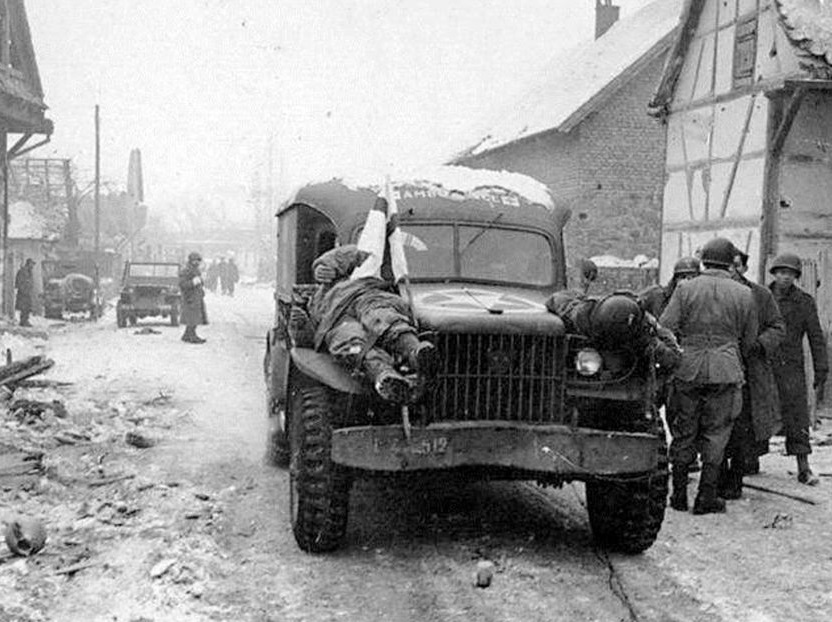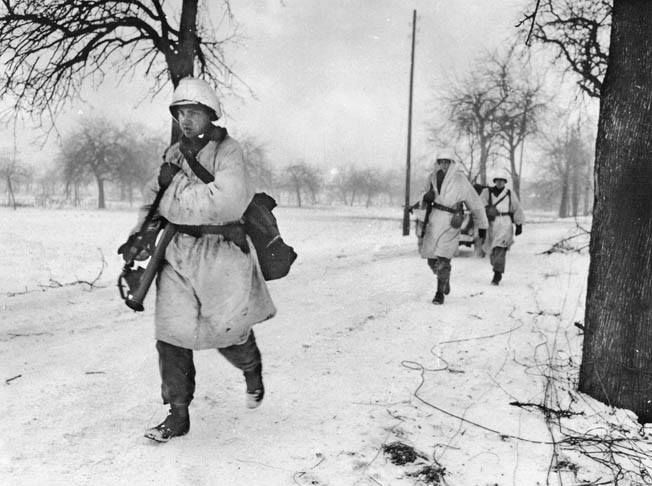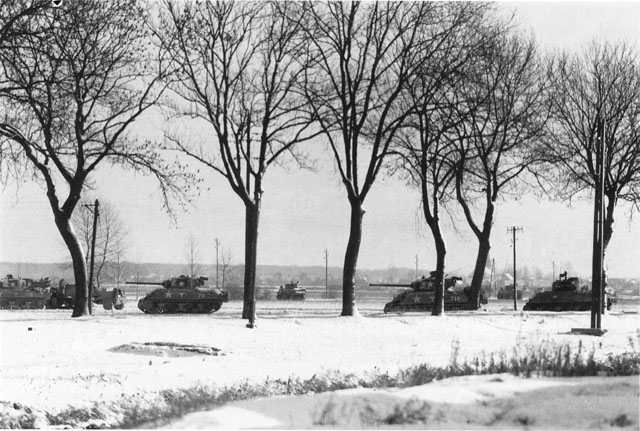During this time two more men were discovered in the ditch, a rifleman and the section leader of the light machine gun. Both were a short distance to the east and both had weapons that had jammed, an M-1 rifle, and an M-1 Thompson sub-machine gun. Bullets cracked across the top of the stream without let up, their sound constituting a constant reminder that there were still Americans on one side of the field and Germans on the other side. The trapped men were themselves so close to the German positions that they could hear enemy soldiers talking. All five of the survivors were exhausted. Mentally and physically. The ice often cracked under their weight and they lay in icy water an inch deep. They crawled out of one bad spot only to slide into another until they were so tired and wet and cold that they frequently stopped and lay where they were, water or not. They took off their gloves in order to rub snow into their fingers and to massage their hands, in an almost hopeless effort to restore circulation. Their toes and feet were a cold numbness in sweat-wet shoepacks. To crawl was an exhausting struggle. The men stopped often and rested on their sides or backs, in order to relieve strained, cold muscles. Small arms fire constantly crisscrossed just over their heads above the stream and artillery fire crashed and crunched on either side of the narrow ditch, sending pieces of hot shrapnel flying into the snow about them.
Their progress was snail-like. In an hour they had covered perhaps 50 yards. In two hours, they had not moved more than 100 yards from their original positions. They were discouraged, too, by the discovery, from the small arms fight, that the Germans had moved over to bolster that weak right flank and that probably already the enemy stood astride the point where the stream turned and entered the tree line.
At about 1000, all of the small arms firing increased in intensity, following an unusually heavy concentration of friendly artillery. Shortly thereafter, Pfc Hubbs made the discovery that Americans were in the stream bed to the west, in approximately the positions from which the five men had spent all morning escaping. These men whom the squad leader saw proved to be the left flank of an attacking force formed by George Co and a reorganized Easy Co. When this yelling line of men leaped out of the ditch and closed with the enemy, the five men left from the 3rd Plat of Baker Co joined in on the charge, keeping their position about 100 yards to the left of the larger force. They overran several Germans in a ditch paralleling the Ostheim road which ran across the front of the woods. Three of the men remained in this ditch, while the platoon leader and Pfc Spaeth, who had the only two weapons functioning, pursued an escaping German machine-gun crew southeastward.
Twice this group stopped and attempted to set up the gun, but each time an accurate 30 caliber fire from the M-1 and carbine broke up their efforts. The crew of about six men lost several members, either wounded or frightened into wild plunges for escape. This enemy crew eventually disappeared in some bushes among the trees. By the time the two Americans had approached this position cautiously, no trace of the enemy was there.
The two men were now exactly on the northeastern corner of the Rothleible Woods, from where they could look south down the huge open field which lies to the east of these woods. They were in an excellent position to fire upon anything or anyone breaking from the eastern edge of the woods away from the assault forces, so threw themselves against a mound of earth and watched. They were rewarded almost immediately. Approximately 400 yards away, about 30 men broke from the cover of the forest. A number of white-camouflaged figures among these Germans were mistaken for American prisoners and so the group was not initially fired upon. The two Americans soon saw that these white figures were also enemies, however, and took the group under fire with both the carbine and M-1. The carbine proved useless at this range, which rapidly grew as the enemy soldiers ran across the field away from the woods. Once under fire, many of these Germans hit the ground and crawled in the snow. Several were knocked down by the rifle fire but much the greater number simply ran, until they could take shelter in what was either an irrigation ditch or a stream about 400 yards out in the field. Here they took cover and were concealed from both view and small-arms fire.
All this while, shots and cries had been coming from the interior of the woods. No further enemy issued out into the open field on the eastern fringe, however, and so eventually the platoon leader and his squad leader returned to the point where they had left the other three men. Thus reunited, the small band set off west along the Ostheim road in search of Easy Co.
One of the first persons encountered was Maj Duncan, by the side of the road just outside the woods. All about the major lay evidence of the terrific pomading given this area by American artillery. Torn trees and limbs littered the snow-covered ground, the snow itself was churned up and beaten about in wild disorder, the debris from a routed enemy lay scattered about, and out in the field itself lay the human jetsam and debris left by the battalion in its two assaults across the field. George Co in shouldering the main load of the daylight attack had suffered severe casualties and men of this company, including the company radio operator with his SCR-300, lay on the field in numbers greater even than those of Easy Co’s men. Maj Duncan himself was seeking to contact the company commanders of Easy and George Cos and at this time knew only the general location of these units, which had plunged into the woods, where their men engaged in any number of small, isolated actions. But the major pointed out the area where Easy Co had crossed the field this second time; and after a few minutes of search, the five men had relocated Capt Powell and scattered elements of the company, including S/Sgt Adams, the 3rd Plat’s guide, and five other men of the 3rd Plat. These six, with the four who had been trapped in the stream bed (the fifth man in the stream was the machine-gun section leader, it will be recalled), made a total of ten survivors of the platoon which had crossed the Fecht River the previous night.
S/Sgt Adams was glad to reunite his six men with the four from the stream bed. The sergeant had had the difficult task of reorganizing survivors on the edge of the Colmar Forest that morning and of leading this small group back across the field in the daylight assault. A hasty reorganization was necessary. The platoon still had all three of its squad leaders, as well as its platoon guide and its platoon sergeant-leader. But the small band of men was short on ammunition a number of weapons, particularly sub-machine guns, were still not functioning in good order, and no one had any food. All of these deficiencies were replenished by a quick salvage trip back out to the field among the dead and wounded. The platoon, even while still in process of this reorganization, joined with the rest of the company in a movement to the eastern edge of the Rothleible Woods to the southernmost of four fingers of woods jutted out from the main forest itself. Here the company was looking out over the same open terrain that the 3rd Plat leader and his non-commissioned officer had fired across an hour earlier. The company was ordered to dig hasty shelters here.
Progress of the whole battalion was held up at this point, while Fox Co was sent on a mission to clear the zone behind the battalion of large numbers of the enemy who had infiltrated from the flanks. This delay enabled the 3rd Plat of Easy Co to reconstitute itself in all supplies, both weapons, and ammunition. The cries of several wounded Germans in the woods behind them were especially wracking during this entire period, but nothing could be done for these wounded. The battalion medics and company aidmen were all busy with Americans in the field some 600 yards to the rear. By approximately 1450, Fox Co had reported its mission accomplished. The battalion commander gave the order for the battalion to continue on south through the Rothleible Woods, with the task of clearing all enemies from the timber. The formation of this attack consisted again of Easy and George Cos abreast, with Baker on the left and George on the right. Easy Co placed all of its riflemen on a single skirmish line, whose left flank guided on the eastern edge of the woods. The right flank of the company tied in with a skirmish line formed by George Co. In this formation, the 3rd Plat of Easy Co occupied the center of the line in its company, with Lt Conklin’s 2nd Plat on its left and the 1st Plat (which had lost its platoon leader that morning) on the right. Thus, as part of a huge dragnet cast across the eastern half of the woods, the 3rd Plat moved out in the attack once more.
The sky was the gray overcast of winter, the light clear and bright. Visibility in the woods, which had less underbrush than the Colmar Forest to the north, was excellent and the trees were once again tall giants against the wintry sky. The long skirmish line moved steadily forward. About two-thirds of the way to the southern tip of the Rothleible tree belt lies a house, the Rothleible House, situated on the eastern edge of the trees. This house, facing south, nestles back under the shelter of the high trees. As they approached this building, the American riflemen discovered ahead of them under the trees huge log and earth shelters, with some enemy. The skirmishers opened fire on these hostile troops and on the doors and windows of the rude shelters. Everyone was tired, so the line simply employed marching fire, moving in at a steady walk. The enemy was seen to turn and run among the trees up ahead, away from the log shelters toward the Rothleible House and past it across a road and so out into the woods beyond. The 3rd Plat had the log shelters and the house directly in its path. Its men closed in on these shelters, to each of which the platoon leader sent one or two men as clearing parties.
The main line of men continued on to the road fronting the Rothleible House. This road out the woods from west to east on almost a straight line. Capt Powell of Easy Co and Capt Leonard D. Hanney of George Co contacted each other here and agreed to hold up at this road. The 3rd Plat moved on across the road to several barns. Here the men were posted to cover the front to the south, and security was sent out into the woods itself, which here became a rough growth of wild underbrush and small trees, with only a few tall trees like those through which the platoon had been advancing. Visibility was cut to a minimum in this underbrush.
German forces in the heart of this wilderness could be heard shouting at each other. Numerous fresh snow trails beginning at the road and heading straight south showed where a considerable body of enemy troops had escaped just ahead of the battalion. The platoon CP was located inside one of the barns, which the Germans had cleverly used as camouflage for two small, dirt-reinforced rooms which could have withstood any amount of artillery fire, no matter what happened to the outer shell of the barn itself. Double bunks along the walls of these two rooms provided living accommodations for about 16 men altogether. Abandoned German rations, including the enemy’s sour soldier bread, were salvaged and consumed by 3rd Plat men. The platoon spent about half an hour here when a runner from Capt Powell brought warning that Easy and George Cos were to move out again and finish clearing the southern third of the woods.
Because of the wild jumble of underbrush immediately to the front, the two companies swung to the western half of the woods, to the other side of an unimproved north-south road that out the entire length of the woods. The left flank of Easy guided on this north-south road. In this sector, the forest once more took on an open, clear aspect, under tall trees. The 3rd Plat again was the middle element of a skirmish line consisting of all three platoons abreast. The men had scarcely begun to move south when enemy artillery began to lay unobserved harassing fire into the woods where tree bursts high in the air sent shrapnel whistling and crackling down to the ground.
Unaware of the exact location of the American troops, the enemy scattered this deadly fire indiscriminately across the length and breadth of the woods. Some casualties were suffered from the tree bursts which occasionally hit in the vicinity of the advancing companies, and there was a general tendency for the advance to slow down, nevertheless, the men continued to move forward until they were within 80 yards of the southern limits of the woods. Here, looking south from the trees, the men could observe German troops in the field between the woods and the town of Houssen. Able Co order was given for the men to dig in where they stood.
A long half circle, with its left flank the 2nd Plat of Easy Co near the north-south road through the woods and its right flank the farthest elements of George Co, was the defensive formation now set up by the 2nd Battalion. In this defense, the 3rd Plat of Easy Co occupied positions to the right of Lt Conklin’s 2nd Plat. The men paired up and set to digging two-man fighting holes. They dug holes of a standard type in the platoon, holes which had an open-end similar to the field-manual type fighting hole for two men but which had also a portion that could be covered for overhead protection with logs or tree limbs for crosspieces, covered with a blanket or gas protective caps and topped with the dirt excavated from the hole itself, these standard holes gave a maximum of protection and a strong boost in morale to the owners. Such holes also took a long time to build. They began with a shallow shelter from which two kneeling men could fight and were then enlarged as time permitted. By midnight men of the 3rd Plat, all had completed some such hole, digging it in the ground which proved to be bandy and surprisingly easy to work once a shallow frozen crust of the earth was penetrated.
About dusk, the southern edge of the woods was lashed by a storm of enemy artillery. Ear-splitting tree bursts whipped the area with shrapnel, causing casualties in George Co and also in Lt Conklin’s platoon in Easy Co, this artillery continued for some while, ceased, and then was picked up again spasmodically until about 2000, when it stopped. The night itself came clear and cold. Dead tired, the men were allowed to have half their number sleep; but one man was kept awake in each hole all night. The platoon leader, who had lost his runner in the morning attack, shared a foxhole with his platoon guide – and these two men alternately caught fitful sleep throughout the night.
The wakeful member prowled through the platoon area, keeping sleepy men awake and alert. After dark, word was received that the 1/7 would take over the mission of capturing the Chateau de Schoppenwihr, and during the night these troops moved through George Co and out into the country to the west, where they met stiff opposition from enemy automatic weapons, tanks, and artillery. All night the side of the woods facing toward the Chateau was kept fitfully alive with the light and noise and sounds of battle.
The 3rd Plat of Easy Co had no attack to make. The area immediately in front of it, south towards Houssen, was quiet this night. For purposes of this monograph, no effort will be made to describe the actions of the platoon past the period already covered, which includes the night January 23-24. Mention must be made, however, that the platoon played a prominent role in all subsequent actions of the company and battalion – and once, in Wihr-en-Plaine, teamed with Lt Conklin’s platoon with the regimental Battle Patrol, and with elements of the battalion CP group to fight off a combined tank-infantry counterattack by an overwhelming German force. At one time the platoon was down to four effective. Two privates of this platoon, killed in action during the Colmar pocket attack in the period January 22 through February 8 1945, were awarded the Distinguished Service Cross posthumously.























